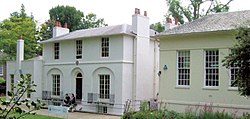Events
- January 30 – Romney Literary Society is established in the United States as the Polemic Society of Romney, West Virginia. [1]
- April – John Keats begins his "Great Year" or "Living Year", during which he is at his most productive, having given up work at Guy's Hospital and moved into a new house, Wentworth Place, on Hampstead Heath on the edge of London. On April 3, Charles Wentworth Dilke lets his house, next door to Keats, to Mrs Brawne, whose daughter Fanny would become the love of Keats's life. Between April 21 and the end of May Keats writes La Belle Dame sans Merci and most of his major odes: Ode to Psyche , Ode on a Grecian Urn , Ode to a Nightingale , Ode on Indolence and Ode on Melancholy . In the summer he writes Lamia ; on September 19 he writes his ode To Autumn at Winchester; [2] and on October 19 proposes marriage to Fanny.

- April 1 – In London The New Monthly Magazine publishes John Polidori's Gothic fiction The Vampyre , the first significant piece of prose vampire literature in English, attributing it to Lord Byron (who partly inspired it). It is first published in book form later in the year.
- June 21 – Walter Scott's historical Waverley Novels The Bride of Lammermoor and A Legend of Montrose are published anonymously by Archibald Constable in Edinburgh as the 3rd series of Scott's Tales of My Landlord. They have been partly dictated due to Scott's suffering from biliary colic earlier in the year. [3]
- June 23 – Washington Irving begins publishing The Sketch Book of Geoffrey Crayon, Gent. in seven installments — the first including "Rip Van Winkle" and a later one including "The Legend of Sleepy Hollow" — simultaneously in New York and London (where Irving is living at this time).
- August 16 – The Peterloo Massacre takes place in England, inspiring Percy Bysshe Shelley, in Italy, who, like Keats, has one of his most productive years. After hearing the news on September 5 he writes The Masque of Anarchy and sends it to a newspaper (although it is not published until 1832, after his death), also writing the political sonnet England in 1819 (published 1839), Ode to the West Wind (published 1820), The Cenci: A Tragedy, in Five Acts (printed in Italy, but not first performed publicly until 1922) and Julian and Maddalo (published in his Posthumous Poems of 1824) and beginning his prose work A Philosophical View of Reform .
- September 20 – The Carlsbad Decrees are issued throughout the German Confederation, suppressing liberal and nationalist views and censoring the press.
- October – In Britain, Richard Carlile is convicted of blasphemy and sent to prison for publishing The Age of Reason by Thomas Paine.
- December 20 – Walter Scott's popular Waverley Novel Ivanhoe is published anonymously in 3 volumes by Archibald Constable in Edinburgh, dated 1820. A chivalric romance set in 12th-century England, it represents a move away from Scott setting his fiction in Scotland. [3]
- unknown dates
- Joseph Perl's epistolary novel Megalleh Temirim ("Revealer of Secrets"), written under the name "Obadiah ben Pethahiah" and published in Vienna, becomes the first novel to be published in the Hebrew language. [4]
- The publisher Collins is founded as a printer of religious literature in Glasgow by William Collins.
- W. & R. Chambers, established by bookseller brothers William Chambers and Robert Chambers in Edinburgh, begin publishing with a posthumous collection of The Songs of Robert Burns .